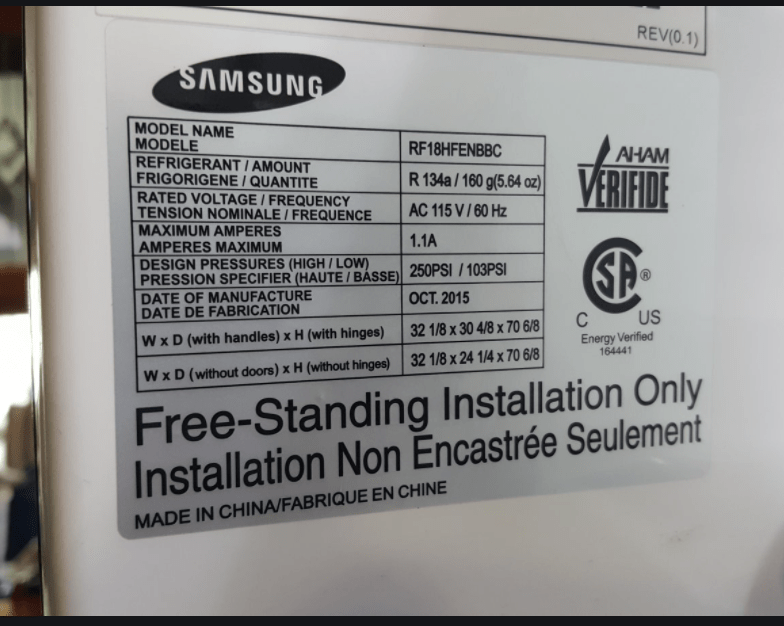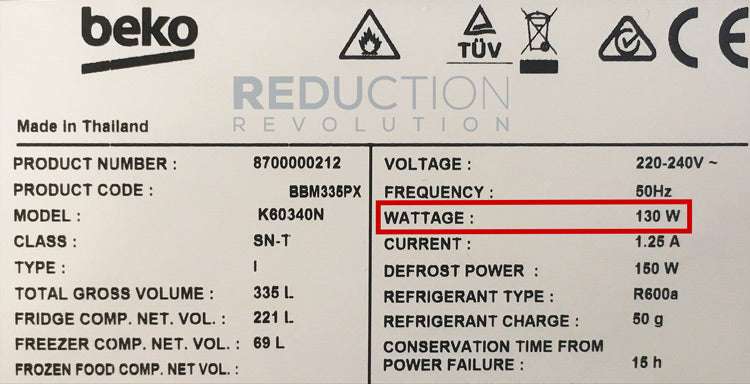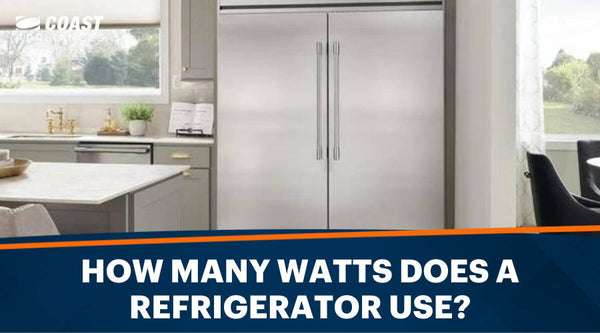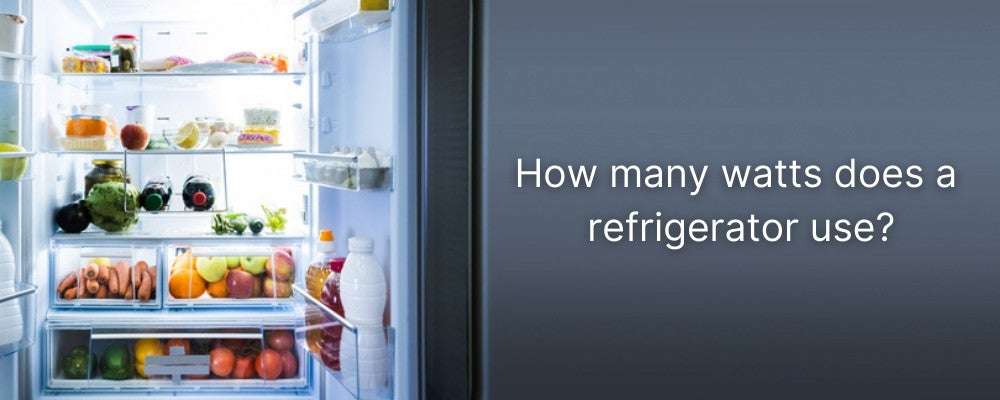So you’re wondering how much power your refrigerator really needs to keep your food nice and cold? Well, you’re in the right place. In this article, we’ll be taking a closer look at how many running watts a typical refrigerator requires. Whether you’re trying to figure out the right size generator for your home or simply curious about energy consumption, we’ve got all the answers for you. So sit back, relax, and let’s dive into the world of refrigeration wattage.

Factors Affecting Refrigerator Power Consumption
Age and Type of Refrigerator
The age and type of a refrigerator can significantly impact its power consumption. Older refrigerators tend to use more energy compared to newer models. This is because older refrigerators are not designed with the same energy-saving features and technologies that are found in modern refrigerators. Additionally, the type of refrigerator can also affect power consumption. For example, side-by-side refrigerators generally use more energy than top or bottom freezer models.
Size and Capacity
The size and capacity of a refrigerator can also affect its power consumption. Larger refrigerators typically require more energy to operate compared to smaller ones. This is because larger refrigerators have to cool a larger interior space and often have more features, such as additional doors or compartments, that require power. When considering purchasing a refrigerator, it’s important to consider your actual storage needs to avoid unnecessarily high power consumption.
Temperature Setting
The temperature setting of a refrigerator can greatly impact its power consumption. The colder the temperature setting, the more energy it will require to maintain that low temperature. It’s recommended to set the refrigerator temperature between 35 and 38 degrees Fahrenheit (1.7 and 3.3 degrees Celsius) for optimal energy efficiency. Make sure to check the user manual or consult the manufacturer’s guidelines for the best temperature setting for your specific refrigerator model.
Frequency of Opening the Door
The frequency of opening the refrigerator door can have a significant impact on its power consumption. Every time the door is opened, warm air enters the refrigerator and the compressor has to work harder to restore the desired temperature. To minimize energy consumption, it’s important to minimize the duration and frequency of door openings. This can be achieved by being organized and taking out all the needed items at once or using clear containers to easily identify the items inside the refrigerator.
Calculating Running Watts
Understanding Power Consumption
Before calculating the running watts of a refrigerator, it’s important to understand what power consumption means. Power consumption refers to the amount of electrical energy used by an appliance over a certain period of time. It is typically measured in watts (W) or kilowatts (kW). For example, a 100-watt light bulb consumes 100 watts of power per hour.
Determining Average Power Consumption
To determine the average power consumption of a refrigerator, you can use a wattmeter or a power meter. These devices can measure the actual power being consumed by the refrigerator. Simply plug the refrigerator into the wattmeter or power meter and monitor the power consumption over a period of time, such as 24 hours. Once you have the total power consumption, divide it by the number of hours to calculate the average power consumption in watts.
Average Power Consumption of Refrigerators
Standard Refrigerator Power Consumption Range
The average power consumption of refrigerators can vary depending on factors such as size, age, and energy efficiency. On average, a typical refrigerator consumes between 100 and 400 watts. Larger refrigerators generally fall on the higher end of this range, while smaller ones tend to consume less power. It’s important to note that these are average values, and actual power consumption may vary depending on the specific refrigerator model and usage habits.
Energy Star Rated Refrigerators
Energy Star rated refrigerators are designed to meet strict energy efficiency guidelines set by the Environmental Protection Agency (EPA). These refrigerators are designed to consume less energy compared to standard models without compromising performance. Energy Star rated refrigerators can save up to 15% more energy than non-certified models. When purchasing a new refrigerator, choosing an Energy Star rated model can help reduce power consumption and lower energy bills.
Older Refrigerators Power Consumption
Older refrigerators, especially those manufactured before energy efficiency standards were implemented, tend to have higher power consumption compared to newer models. These older units often lack the energy-saving technologies found in modern refrigerators, leading to inefficient energy usage. If you have an older refrigerator, consider upgrading to a newer, more energy-efficient model to reduce power consumption and save on energy costs in the long run.
Effect of Energy Efficiency on Power Consumption
Energy Efficiency Ratings
Energy efficiency ratings can provide valuable information about a refrigerator’s power consumption. These ratings are often displayed as Energy Guide labels and provide an estimate of the refrigerator’s annual energy usage. The higher the energy efficiency rating, the less energy the refrigerator is expected to consume. When comparing different refrigerator models, look for higher energy efficiency ratings to ensure lower power consumption.
Environmentally Friendly Refrigerants
Another aspect of energy efficiency is the type of refrigerant used in the refrigerator. Traditional refrigerants such as R-12 and R-22 are known for their high global warming potential and ozone-depleting properties. Newer refrigerants, such as R-410A and R-600a, are more environmentally friendly and require less energy to operate. Choosing a refrigerator with an environmentally friendly refrigerant can contribute to lower power consumption and a greener environment.

Refrigerator Power Consumption Tips
Regular Maintenance
Regular maintenance can help optimize the power consumption of your refrigerator. Keep the coils at the back or bottom of the refrigerator clean and free from dust and debris. This allows for better heat dissipation, reducing the workload on the compressor and improving energy efficiency. Additionally, check the door seals regularly to ensure they are well-fitted and do not allow air leakage, as this can lead to increased power consumption.
Optimal Temperature Setting
Setting the refrigerator to the optimal temperature range can help minimize power consumption. As mentioned earlier, a temperature setting between 35 and 38 degrees Fahrenheit (1.7 and 3.3 degrees Celsius) is generally recommended. Avoid setting the temperature lower than necessary, as it will increase energy usage without providing any significant benefit in terms of food preservation.
Smart Usage Habits
Adopting smart usage habits can significantly impact power consumption. Avoid leaving the refrigerator door open for extended periods and make sure it is fully closed after each use. Plan your meals and take out all the required items at once, rather than opening the refrigerator multiple times. Additionally, allow hot or warm food to cool down before placing it in the refrigerator, as this reduces the workload for the cooling system.
Proper Location
Properly positioning your refrigerator can also affect its energy efficiency. Avoid placing the refrigerator near a direct heat source, such as an oven or dishwasher, as the heat can cause the compressor to work harder and consume more power. Ensure there is enough space around the refrigerator for proper air circulation and ventilation.
Consider Energy Star Rated Refrigerators
If you are in the market for a new refrigerator, consider purchasing an Energy Star rated model. These refrigerators are rigorously tested for energy efficiency and offer significant energy savings compared to non-certified models. While the initial cost may be slightly higher, the long-term energy savings can offset the higher price.
Power Source and Voltage Requirement
AC or DC Power
Refrigerators typically operate on AC (alternating current) power, which is the standard electrical power supplied by utility companies. Most household outlets provide AC power, making it convenient to use refrigerators without the need for additional equipment. However, there are also models available that can operate on DC (direct current) power, which is commonly used in recreational vehicles (RVs), boats, and off-grid applications.
Voltage Compatibility
When considering a refrigerator, it’s important to ensure that the voltage requirements are compatible with the power supply in your location. In most countries, the standard voltage for residential areas is 120 volts or 230 volts, depending on the electrical system. Using a refrigerator with the correct voltage compatibility ensures optimal performance and prevents any potential electrical issues.

Impact of Additional Features
Ice Makers
Refrigerators with built-in ice makers can increase power consumption. Ice makers require additional energy to operate, including powering the water valve and the motor that moves the ice cubes into the dispenser. If you rarely use ice or prefer to make ice manually, consider purchasing a refrigerator without a built-in ice maker to reduce power consumption.
Water Dispensers
Similar to ice makers, refrigerators with water dispensers require additional energy to operate the water valve and maintain the water temperature. If you do not use the water dispenser frequently, consider opting for a refrigerator without this feature to save on power consumption.
LED Displays
Refrigerators with LED displays or digital control panels also contribute to power consumption. While these displays provide convenience and modern aesthetics, they require constant power to operate. Consider whether the benefits of having an LED display outweigh the additional power consumption when choosing a refrigerator.
Power Surge Requirements
Managing Voltage Fluctuations
Power surges and voltage fluctuations can potentially damage refrigerators and other appliances. It is essential to protect your refrigerator from power surges by using surge protectors or voltage stabilizers. These devices help regulate the voltage and protect against sudden spikes or drops in electrical power, ensuring the safe operation and longevity of your refrigerator.
Alternative Power Solutions
Generator
In areas with frequent power outages or for off-grid applications, a generator can be used as an alternative power source for refrigerators. Generators are available in different sizes and power outputs, allowing you to choose the one that suits the power requirements of your refrigerator. However, it’s important to consider factors such as fuel availability, noise levels, and maintenance requirements when deciding to use a generator as a power source.
Solar Power
Solar power is another alternative power solution for refrigerators. By installing solar panels and a battery storage system, you can harness the sun’s energy to power your refrigerator. Solar power systems can be designed to meet the specific power requirements of your refrigerator and provide clean and renewable energy. This option is especially beneficial for those looking to reduce their carbon footprint and rely on sustainable energy sources.
Conclusion
Understanding the factors affecting refrigerator power consumption is essential in optimizing energy usage, reducing electricity bills, and contributing to a greener environment. Factors such as the age, type, size, and efficiency of the refrigerator, as well as individual usage habits, play a significant role in power consumption. By considering energy-efficient options, maintaining the refrigerator properly, and adopting smart usage habits, you can minimize power consumption and make a positive impact on both your energy bills and the environment.

